Chapter 2 Quantization
Click to edit Master subtitle style
Nguyen Thanh Tuan, M.Eng. Department of Telecommunications (113B3) Ho Chi Minh City University of Technology Email: nttbk97@yahoo.com
1. Quantization process
Fig: Analog to digital conversion
The quantized sample xQ(nT) is represented by B bit, which can take
2B possible values.
An A/D is characterized by a full-scale range R which is divided into 2B quantization levels. Typical values of R in practice are between 1-10 volts.
Digital Signal Processing 2 Quantization
1. Quantization process
Fig: Signal quantization
Quantizer resolution or quantization width (step)
A bipolar ADC
A unipolar ADC
Digital Signal Processing 3 Quantization
1. Quantization process
Quantization by rounding: replace each value x(nT) by the nearest
quantization level.
Quantization by truncation: replace each value x(nT) by its below
nearest quantization level.
Quantization error:
Consider rounding quantization:
Fig: Uniform probability density of quantization error
Digital Signal Processing 4 Quantization
1. Quantization process
The mean value of quantization error
The mean-square error (power) Root-mean-square (rms) error:
R and Q are the ranges of the signal and quantization noise, then the signal to noise ratio (SNR) or dynamic range of the quantizer is defined as
which is referred to as 6 dB bit rule.
Digital Signal Processing 5 Quantization
Example 1
In a digital audio application, the signal is sampled at a rate of 44 KHz and each sample quantized using an A/D converter having a full-scale range of 10 volts. Determine the number of bits B if the rms quantization error must be kept below 50 microvolts. Then, determine the actual rms error and the bit rate in bits per second.
Digital Signal Processing 6 Quantization
2. Digital to Analog Converters (DACs)
We begin with A/D converters, because they are used as the building
blocks of successive approximation ADCs.
Fig: B-bit D/A converter
Vector B input bits : b=[b1, b2,…,bB]. Note that bB is the least significant bit (LSB) while b1 is the most significant bit (MSB). For unipolar signal, xQ є [0, R); for bipolar xQ є [-R/2, R/2).
Digital Signal Processing 7 Quantization
2. DACs
Rf
Full scale R=VREF, B=4 bit
xQ=Vout
2Rf
4Rf
8Rf
16Rf
bB
MSB b1
LSB
-VREF
Fig: DAC using binary weighted resistor
Digital Signal Processing 8 Quantization
2. DACs
Unipolar natural binary
where m is the integer whose binary representation is b=[b1, b2,…,bB].
Bipolar offset binary: obtained by shifting the xQ of unipolar natural
binary converter by half-scale R/2:
Two’s complement code: obtained from the offset binary code by
complementing the most significant bit, i.e., replacing b1 by .
Digital Signal Processing 9 Quantization
Example 2
A 4-bit D/A converter has a full-scale R=10 volts. Find the quantized
analog values for the following cases ?
a) Natural binary with the input bits b=[1001] ?
b) Offset binary with the input bits b=[1011] ?
c) Two’s complement binary with the input bits b=[1101] ?
Digital Signal Processing 10 Quantization
3. A/D converters
A/D converters quantize an analog value x so that is is represented
by B bits b=[b1, b2,…,bB].
Fig: B-bit A/D converter
Digital Signal Processing 11 Quantization
3. A/D converters
One of the most popular converters is the successive approximation
A/D converter
Fig: Successive approximation A/D converter
After B tests, the successive approximation register (SAR) will hold
the correct bit vector b.
Digital Signal Processing 12 Quantization
3. A/D converters
Successive approximation algorithm
where the unit-step function is defined by
This algorithm is applied for the natural and offset binary with truncation quantization.
Digital Signal Processing 13 Quantization
Example 3
Consider a 4-bit ADC with the full-scale R=10 volts. Using the successive approximation algorithm to find offset binary of truncation quantization for the analog values x=3.5 volts and x=-1.5 volts.
xQ
C = u(x – xQ) 1 1 0 1
Test b1b2b3b4 b1 1000 0,000 b2 1100 2,500 b3 1110 3,750 b4 1101 3,125 1101 3,125
Digital Signal Processing 14 Quantization
3. A/D converter
For rounding quantization, we
For the two’s complement
shift x by Q/2:
code, the sign bit b1 is treated separately.
Digital Signal Processing 15 Quantization
Example 4
Consider a 4-bit ADC with the full-scale R=10 volts. Using the successive approximation algorithm to find offset and two’s complement of rounding quantization for the analog values x=3.5 volts.
Digital Signal Processing 16 Quantization
Oversampling noise shaping
Pee(f)
e(n)
HNS(f)
f
0
-f’s/2
f’s/2
-fs/2
fs/2
x(n)
ε(n)
xQ(n)
Digital Signal Processing 17 Quantization
Oversampling noise shaping
Digital Signal Processing 18 Quantization
Dither
Digital Signal Processing 19 Quantization
Uniform and non-uniform quantization
Digital Signal Processing 20 Quantization
Mid-riser and mid-tread quantization
Digital Signal Processing 21 Quantization
Bonus 2.1
Write a program to simulate DAC.
MSB
b1 b2 b3
xQ
DAC
bB
LSB
R (full-scale range)
Digital Signal Processing 22 Quantization
Bonus 2.2
Write a program to simulate ADC.
MSB
x(n)
b1 b2 b3
ADC
bB
LSB
R (full-scale range)
Digital Signal Processing 23 Quantization
Review
Các thông số cơ bản của quá trình lượng tử hóa? Quan hệ giữa các nguyên tắc lượng tử? Quan hệ giữa các nguyên tắc mã hóa? Tính chất của sai số lượng tử? Hiệu quả của lấy mẫu dư và định dạng nhiễu? Hiệu quả của dither? Giải thuật test bit? Xác định mức lượng tử và các bit lượng tử? Xác định dung lượng cần lưu trữ? Xác định tốc độ xử lý yêu cầu của chip DSP?
Digital Signal Processing 24 Quantization
Homework 1
Cho bộ lượng tử và mã hóa nhị phân tự nhiên B = 5 bit hoạt động theo nguyên tắc làm tròn gần nhất (rounding) với khoảng lượng tử đều Q = 1.1@ (biết 0 là giá trị lượng tử nhỏ nhất).
a) Xác định giá trị lượng tử lớn nhất? b) Kiểm tra xem liệu giá trị 20.10 có là giá trị lượng tử hay không? c) Xác định giá trị lượng tử tương ứng với từ mã 10011? d) Xác định từ mã của mẫu tín hiệu ngõ vào 20.10? e) Làm lại câu d trong trường hợp B = 8 bit?
Digital Signal Processing 25 Quantization
Homework 2
Cho bộ lượng tử và mã hóa nhị phân tự nhiên 8 bit hoạt động theo nguyên tắc làm tròn gần nhất (rounding) với khoảng lượng tử đều Q = 0.4@ (biết 0 là giá trị lượng tử nhỏ nhất).
a) Xác định giá trị lượng tử lớn nhất? b) Kiểm tra xem liệu giá trị 24.04 có là giá trị lượng tử hay không? c) Xác định giá trị lượng tử tương ứng với từ mã 00111101? d) Xác định từ mã của mẫu tín hiệu ngõ vào 20.13? e) Dùng giải thuật test bit, xác định từ mã của mẫu tín hiệu ngõ vào
25.03?
f) Đề xuất 1 giải pháp để thực hiện lượng tử theo nguyên tắc rút bớt (làm tròn xuống) trong trường hợp vẫn sử dụng bộ lượng tử và mã hóa hoạt động theo nguyên tắc làm tròn trên?
Digital Signal Processing 26 Quantization
Homework 3
Cho bộ lượng tử và mã hóa nhị phân tự nhiên 8 bit hoạt động theo nguyên tắc làm tròn với khoảng lượng tử đều Q = 0.1@ (biết 0 là giá trị lượng tử nhỏ nhất).
a) Xác định giá trị lượng tử lớn nhất? b) Xác định giá trị lượng tử tương ứng với từ mã 11100011? c) Xác định từ mã của mẫu tín hiệu ngõ vào 22.07? d) Dùng giải thuật test bit, xác định từ mã của mẫu tín hiệu ngõ vào
9.05?
e) Giả sử tín hiệu phân bố đều trong tầm hoạt động, tính tỉ số công
suất tín hiệu trên nhiễu SNR của bộ lượng tử trên?
Digital Signal Processing 27 Quantization
Homework 4
Cho bộ lượng tử lưỡng cực đối xứng hoạt động theo nguyên tắc làm tròn với khoảng lượng tử đều Q = 0.2@ (biết 0 là một giá trị lượng tử) và mã hóa nhị phân 8 bit dạng bù 2. a) Xác định giá trị lượng tử lớn nhất và nhỏ nhất? b) Xác định giá trị lượng tử tương ứng với từ mã 10001000? c) Xác định từ mã của mẫu tín hiệu ngõ vào 1.64? d) Dùng giải thuật test bit, xác định giá trị lượng tử của mẫu tín hiệu
ngõ vào 1.64?
Digital Signal Processing 28 Quantization
Homework 5
Một tín hiệu rời rạc được lượng tử và mã hóa bằng bộ chuyển
đổi A/D 4 bit có tầm toàn thang R=1@ V dùng giải thuật xấp xỉ liên tiếp làm tròn xuống (truncation).
a) Hãy xác định khoảng lượng tử Q? b) Tìm giá trị lượng tử xQ cho giá trị rời rạc x=2.75 V và từ mã
b=[b1 b2 b3 b4] tương ứng cho mã offset?
c) Lặp lại câu b) cho mã bù hai?
Digital Signal Processing 29 Quantization





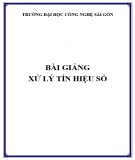
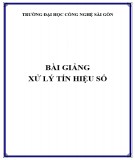
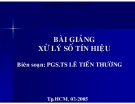
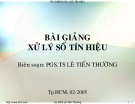
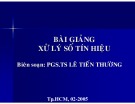
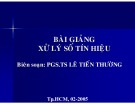





![Đề thi cuối học kì 2 môn Cấu trúc dữ liệu và giải thuật [kèm đáp án/mới nhất]](https://cdn.tailieu.vn/images/document/thumbnail/2025/20251014/lakim0906/135x160/89711760416179.jpg)


![Tài liệu Nhập môn Học máy và Khai phá Dữ liệu [chuẩn nhất]](https://cdn.tailieu.vn/images/document/thumbnail/2025/20251001/kimphuong1001/135x160/531759303870.jpg)






